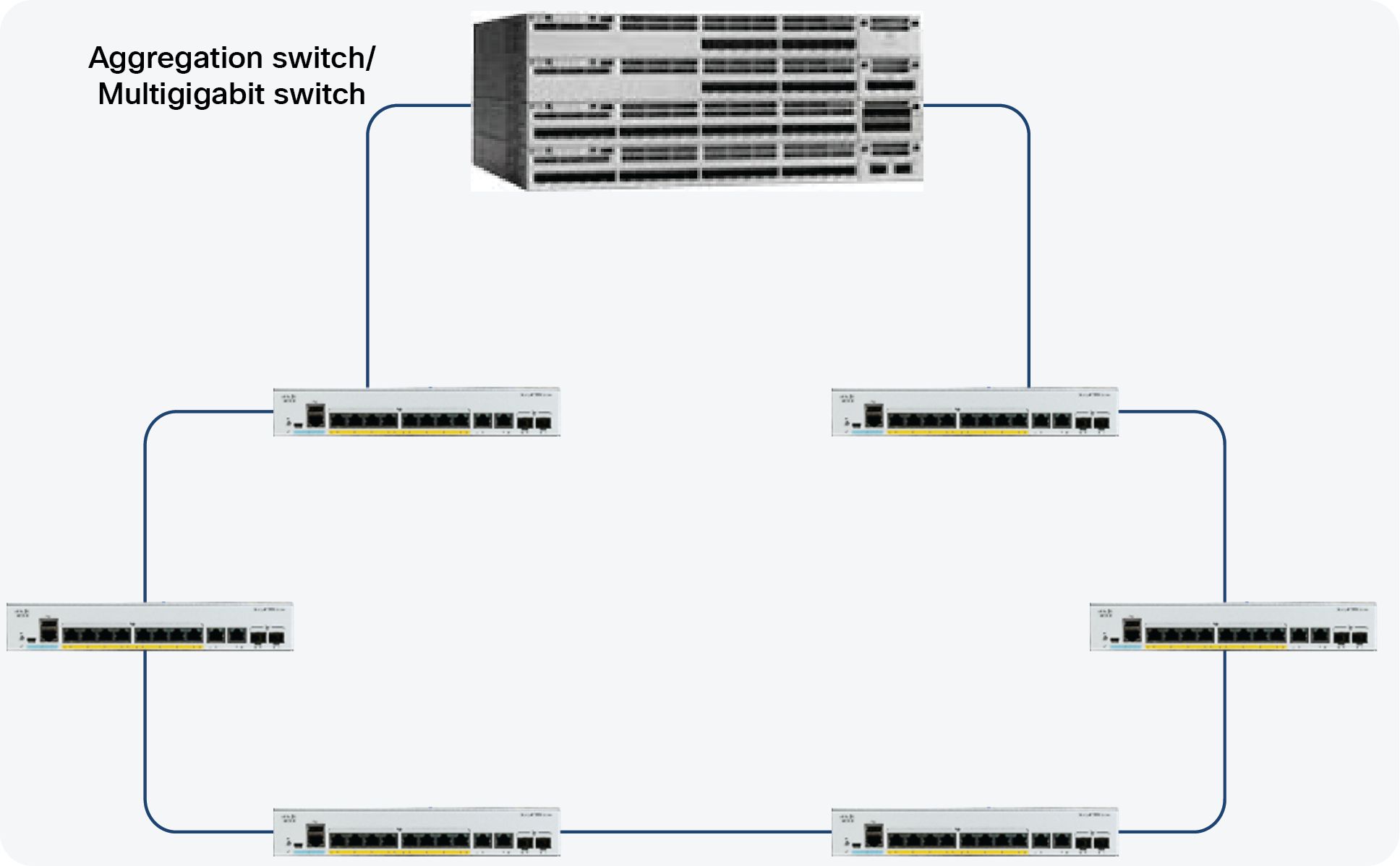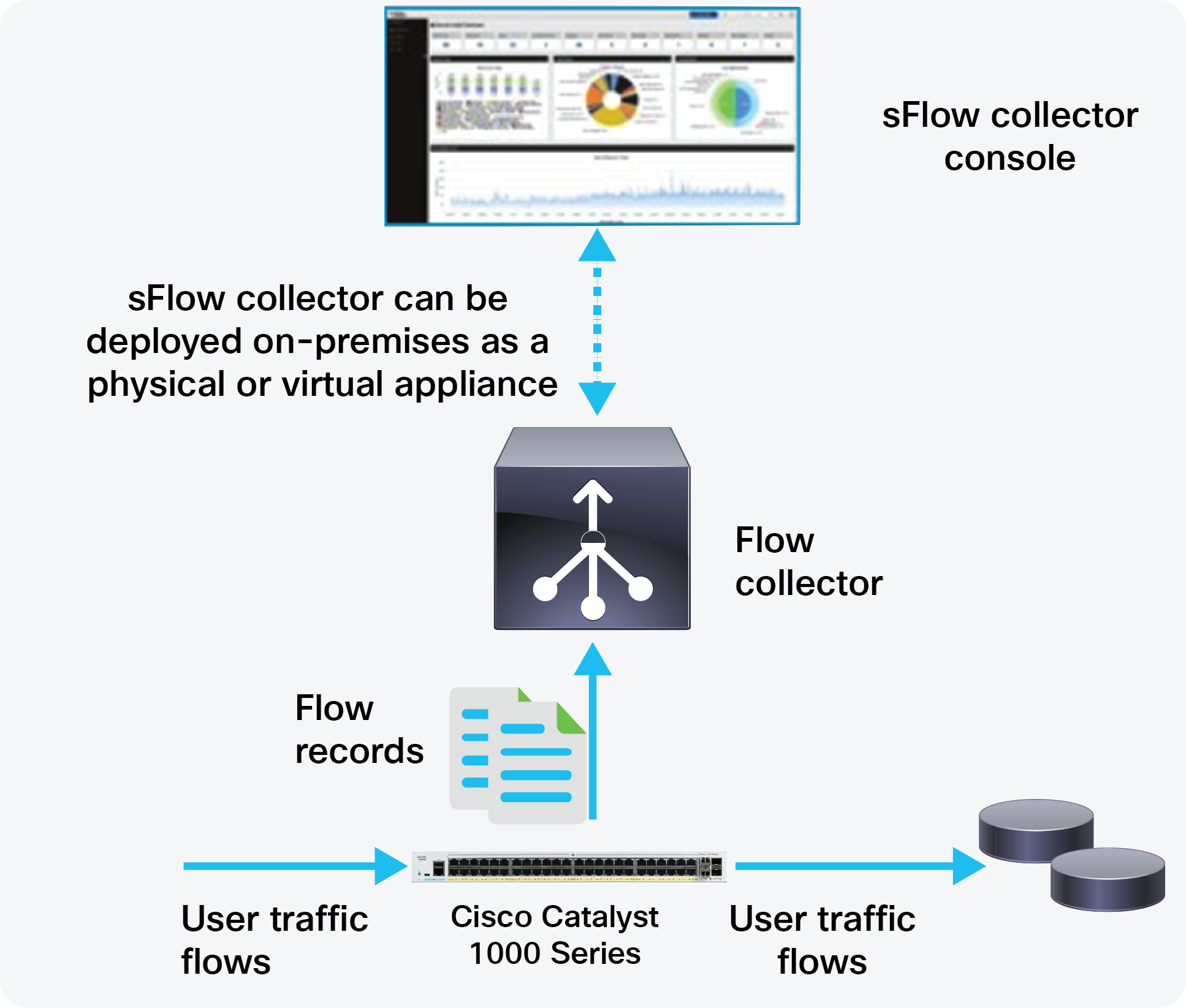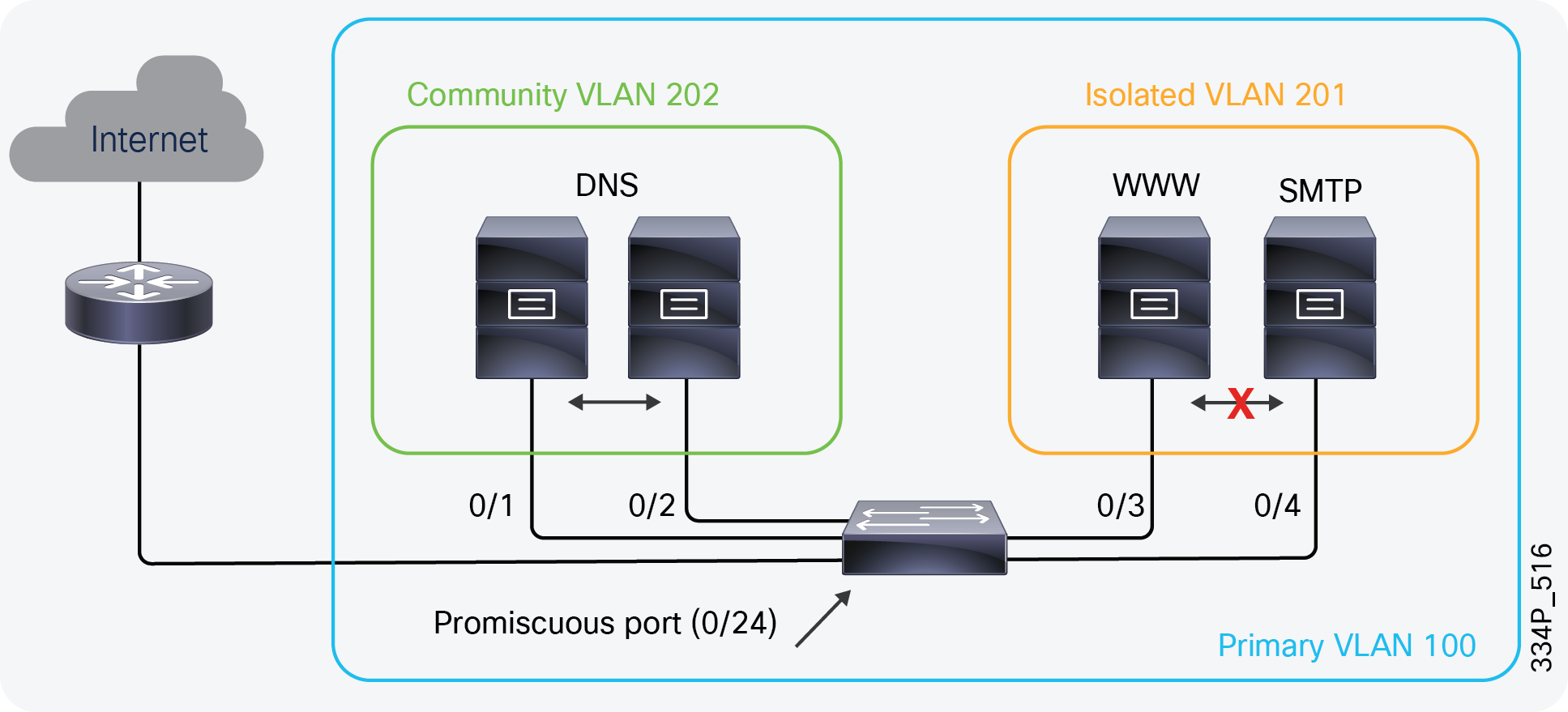Migration Guide from Cisco Catalyst 2960-L and 2960-Plus Series Switches to the Cisco Catalyst 1000 Series
Available Languages
Bias-Free Language
The documentation set for this product strives to use bias-free language. For the purposes of this documentation set, bias-free is defined as language that does not imply discrimination based on age, disability, gender, racial identity, ethnic identity, sexual orientation, socioeconomic status, and intersectionality. Exceptions may be present in the documentation due to language that is hardcoded in the user interfaces of the product software, language used based on RFP documentation, or language that is used by a referenced third-party product. Learn more about how Cisco is using Inclusive Language.
The new Cisco® Catalyst® 1000 Series Switches are fixed managed Gigabit Ethernet enterprise-class Layer 2 switches designed for small businesses and branch offices. These simple, flexible, and secure switches are ideal for out-of-the-wiring-closet and critical Internet of Things (IoT) deployments.
Cisco Catalyst 1000 Series Switches operate on Cisco IOS® Software and support simple device management and network management via a Command-Line Interface (CLI) as well as an on-box WebUI. These switches deliver enhanced network security, network reliability, and operational efficiency for small organizations.

Cisco Catalyst 2960-L, 2960-Plus, and 1000 Series Switches
This document is intended to help network planners and engineers who are familiar with the Cisco Catalyst 2960-L and 2960-Plus Series Switches migrate to the Cisco Catalyst 1000 Series.
The Cisco Catalyst 1000 Series Switches provide simplicity, flexibility, and security for small businesses. Compact form factors, quiet, fanless operation, and a wide range of Power over Ethernet (PoE) and port combinations make these easy-to-manage switches a great fit whether inside or outside the wiring closet.
With improved hardware and advanced software options, the Cisco Catalyst 1000 Series raises the standard for essential network access, providing enterprise-grade network access sized for small businesses.
The Cisco Catalyst 1000 Series is based on a customized merchant Application-Specific Integrated Circuit (ASIC) and an internal ARM CPU architecture. This switch runs the classic Cisco IOS® operating system, which enables it to support all classic Cisco IOS features.
Table 1 lists the system hardware differences between the Cisco Catalyst 1000 Series and the 2960-L and 2960-Plus Series.
Table 1. System hardware comparison
| 1000 Series |
2960-L Series |
2960-Plus Series |
|
| CPU |
Single-core 800 MHz |
Single-core 800 MHz |
Single-core 600 MHz |
| DRAM |
512 MB |
512 MB |
128 MB |
| Flash on board |
256 MB |
256 MB |
64 MB |
| USB flash storage |
Yes |
No |
No |
| Uplink speeds |
1G/10G/combo |
1G/10G |
1G |
| Downlink speeds |
10/100/1000 |
10/100/1000 |
10/100 |
| Power supply options |
Internal/external |
Internal |
Internal |
| Increased Surge protection |
Yes |
No |
No |
| Maximum PoE budget |
740W |
370W |
370W |
| POE+ |
Yes |
Yes |
No |
| Flexible PoE options* |
Yes |
No |
No |
| Perpetual PoE |
Yes |
Yes |
No |
| Maximum depth |
13.8 in. (35.1 cm) |
11.5 in. (29.2 cm) |
13.1 in. (33.3 cm) |
| RJ45 console |
Yes |
Yes |
Yes |
| IP20 rated |
Yes |
Yes |
Yes |
| Single IP management |
Yes |
No |
No |
| Over-the-air Bluetooth |
Yes |
Yes |
No |
| Fanless* |
Yes |
Yes |
No |
| Operating temperature |
Up to 50°C (122°F)** |
Up to 45°C (113°F) |
Up to 45°C (113°F) |
With a consistent hardware architecture and a code base shared with the rest of the Cisco Catalyst 2960 family, the 1000 Series inherits enhanced software options. These feature sets provide increased resiliency and security.
Table 2 lists the major system software differences between the Cisco Catalyst 1000 Series and the 2960-L and 2960-Plus Series.
Table 2. System software comparison
| Feature |
1000 Series |
2960-L Series |
2960-Plus Series |
|
| Operating system and management |
OS |
Cisco IOS |
Cisco IOS |
Cisco IOS |
| Perpetual license |
Yes |
Yes |
Yes |
|
| On-box WebUI |
Yes |
Yes |
No |
|
| CLI |
Yes |
Yes |
Yes |
|
| Cisco Plug and Play (PnP) |
Yes |
Yes |
No |
|
| Cisco Prime® |
Yes |
Yes |
Yes |
|
| Layer 2 |
Active VLANs |
256 |
256 |
64/255 |
| Unicast MAC addresses |
16,000 |
16,000 |
15,000 |
|
| Dynamic VLAN assignment |
Yes |
Yes |
No |
|
| Maximum spanning tree instances |
64 |
64 |
16 |
|
| Layer 3 |
Static routing |
Yes |
Yes |
Yes |
| IPv4 direct routes |
512 |
512 |
128 |
|
| IPv4 multicast routes |
1024 |
1024 |
256 |
|
| Security |
ACL/ACE entries IPv4 |
600/395 |
384 |
384 |
| ACL/ACE entries IPv6 |
600/256 |
256 |
60 |
|
| IEEE 802.1X |
Yes |
Yes |
Yes |
|
| DHCP snooping |
Yes |
Yes |
No |
|
| First-Hop Security (FHS) |
Yes |
Yes |
No |
|
| Monitoring |
sFlow |
Yes |
Yes |
No |
| Dying Gasp |
Yes |
No |
No |
|
The system default behavior on the Cisco Catalyst 1000 Series is very much the same as that of the Cisco Catalyst 2960-L and 2960-Plus Series, since it runs the same base code. For example, interfaces default to the Layer 2 switch-port mode and IP routing is disabled. However, there are also some differences:
● Bluetooth over-the-air-access: The Cisco Catalyst 1000 Series supports an external Bluetooth dongle that plugs into the USB port on the switch and allows a Bluetooth-based RF connection with external laptops and tablets. Laptops and tablets can access the switch CLI using a Telnet or Secure Shell (SSH) client over Bluetooth. The GUI can be accessed over Bluetooth with a browser. This feature is available on the Cisco Catalyst 1000 and 2960-L Series; it is not available on the 2960-Plus Series.
● On-box WebUI: The Cisco Catalyst 1000 Series supports an on-box WebUI via Cisco Configuration Professional. Cisco Configuration Professional provides a user interface for day-zero provisioning, which enables easy onboarding of the switch. It also has an intuitive dashboard for configuring, monitoring, and troubleshooting the switch. This feature is available on the Cisco Catalyst 1000 and 2960-L Series; it is not available on the 2960-Plus Series.
● External power supply and energy management: The Cisco Catalyst 1000 Series provides support for an external power supply on selected SKUs, compared to built-in power supplies on the 2960-L and 2960-Plus SKUs. It also supports 802.3az Energy Efficient Ethernet (EEE), which enables ports to dynamically sense idle periods between traffic bursts and quickly switch the interfaces into a low-power idle mode, reducing power consumption. EEE is supported on the Cisco Catalyst 1000 and 2960-L Series; it is not available on the 2960-Plus Series.
Table 3 compares the power capabilities of the Cisco Catalyst 1000 Series with those of the 2960-L and 2960-Plus Series.
Table 3. Power comparison
|
|
1000 Series |
2960-L Series |
2960-Plus Series |
| Number of power supplies |
1 (fixed internal/ external) |
1 (fixed internal) |
1 (fixed internal) |
| Voltage (auto-ranging) |
110 to 220VAC in |
110 to 220V AC in |
100 to 240V AC in |
| IEEE 802.3az |
Yes |
Yes |
No |
| External redundant power supply |
No |
No |
Yes, with RPS2300 |
Switch interfaces
Cisco Catalyst 1000 Series Switches have Gigabit Ethernet (1G) and 10 Gigabit Ethernet (10G) ports only. There are various port options, ranging from 8 ports to 48 ports. The interface reference numbering is the same as for the 2960-L and 2960-Plus Series.
Table 4 compares the interface options between the platforms.
Table 4. Interface comparison
| 1000 Series |
2960-L Series |
2960-Plus Series |
|
| Downlinks (RJ45) |
1G/FE |
1G |
Fast Ethernet |
| Uplinks |
2x 1G SFP/RJ45 combo 4x 1G 4x 10G |
2x 1G 4x 1G 4x 10G |
2x 1G 2x 1000BASE-T |
Single IP management
Single IP management is an efficient feature to manage and monitor switches of the network using a single IP address. Switches that support 1G and 10G Small Form-Factor Pluggable (SFP) and SFP+ uplink ports can be part of single IP management. You can use SFP/SFP+ ports with optical cables to connect switches placed at different locations to form a group, where the compact switches are placed in different floors or buildings. You can form half-ring or full-ring topologies based on need, and the remaining uplink ports will continue to work as network ports. This feature is supported only on Cisco Catalyst 1000 Gigabit Ethernet Series Switches.

Single IP management
When you convert a network port to a single IP-managed port, it continues to work as a network port, without any impact on the current running configuration, until the next reload of the device. All current configurations on that particular network port are lost after the reload. When you convert a single IP-managed port back to a network port, it comes up as a network port with the default configuration, after a reload.
Up to eight members can join a group through single IP-managed ports. A group always has one master, and the other devices act as members. You can have a group with one master and one member, the maximum number in the group being eight. The configuration file for all the switches connected in a group is maintained by the master.
The following shows the port status during and after conversion to a single IP managed port.
Before reload:
Device# show switch hstack-ports
Horizontal stack port status :
Gi Ports Stack Port Operational Status Next Reload Status Media Type
--------- ------------ -------------------- ------------------- --------------
Gi1/0/9 1 N/W Port Stack Port Fiber
Device(config)#switch 1 hstack-port 1 GigabitEthernet 1/0/9
Device# copy running-config startup-config
Device# reload
After reload:
Device# show switch hstack-ports
Horizontal stack port status :
Gi Ports Stack Port Operational Status Next Reload Status Media Type
--------- ------------ -------------------- ------------------- --------------
Gi1/0/9 1 Stack Port Stack Port Fiber
This feature is supported only on Cisco Catalyst 1000 Series Switches.
Flexible PoE options
The Cisco Catalyst 1000 Series Switches offer flexible PoE options. The PoE power allocation in the switches is dynamic, and power mapping scales up to a maximum of 740W of PoE+ power. Intelligent power management allows flexible power allocation across all ports.
With Perpetual PoE+, the PoE or PoE+ power is maintained during a switch reload. This is important for critical endpoints such as medical devices and for IoT endpoints such as PoE-powered lights, so that there is no disruption during a switch reboot.
For a full list of features supported on the Cisco Catalyst 1000 Series, use the Cisco Feature Navigator on Cisco.com. For customers familiar with the Cisco Catalyst 2960-L and 2960-Plus Series, the following are a few differences between these switches and the 1000 Series:
Quality of Service (QOS)
Cisco Catalyst 1000 Series Switches offer intelligent traffic management that keeps traffic flowing smoothly. Flexible mechanisms for marking, classifying, and scheduling deliver superior performance for data, voice, and video traffic, all at wire speed.
Traffic management features include up to eight egress logical queues per port and strict priority queuing so that the highest-priority packets are serviced ahead of all other traffic, Shaped Round Robin (SRR) scheduling, and Weighted Tail Drop (WTD) congestion avoidance.
Table 5 compares the QoS features among the platforms.
Table 5. QoS comparison
| 1000 Series |
2960-L Series |
2960-Plus Series |
|
| Queues per port |
8 |
8 |
4 |
| Egress buffer |
1.5 MB per ASIC |
1.5 MB per ASIC |
384 KB per ASIC |
| Differentiated services code point (DSCP) mapping and classification |
Yes |
Yes |
Yes |
| Auto-QoS |
Yes |
Yes |
No |
| 802.1p Class of Service (CoS) |
Yes |
Yes |
Yes |
| QoS trust boundary |
Yes |
Yes |
Yes |
| SRR scheduling |
Yes |
Yes |
Yes |
| WTD congestion avoidance |
Yes |
Yes |
Yes |
Sampled Flow (sFlow)
Cisco Catalyst 1000 Series Switches support sFlow, which allows you to monitor real-time traffic in data networks. It uses the sampling mechanism in the sFlow agent on switches to monitor traffic and to forward the sample data to the central data collector. The sFlow agent periodically samples or polls the interface counters that are associated with a data source of the sampled packets. The data source can be an Ethernet interface or a range of Ethernet interfaces.

sFlow configuration
When you enable sFlow sampling, based on the sampling rate and the hardware internal random number, the ingress packets and egress packets are sent to the CPU as an sFlow-sampled packet. The sFlow agent processes the sampled packets and sends an sFlow datagram to the sFlow analyzer. In addition to the original sampled packet, an sFlow datagram includes information about the ingress port, the egress port, and the original packet length. An sFlow datagram can have multiple sFlow samples.
Table 6 describes the sFlow scale and performance in the Cisco Catalyst 1000 Series.
Table 6. sFlow features
| Feature |
Description |
| Flow support |
Ingress/egress |
| Export format |
sFlow version 5 |
| Interface supported |
Physical interfaces |
| Packet rate |
1000 pps per ASIC |
| Timestamp |
Use system uptime |
Private VLANs
The Cisco Catalyst 1000 Series is Hardware ready for PVLAN. Software support can be added in future. Private VLan also known as port isolation help to partition the Layer 2 broadcast domain of a VLAN into subdomains, allowing you to isolate the ports on the switch from each other. A subdomain consists of a primary VLAN and one or more secondary VLANs. All VLANs in a private VLAN domain share the same primary VLAN.
Types of ports in a private VLAN:
Isolated: Communicates with only promiscuous ports
Promiscuous: Communicates with all other ports
Community: Communicates with the other members of the community and all promiscuous ports

A private VLAN
In the configuration in Figure 4, the DNS, web, and Simple Mail Transfer Protocol (SMTP) servers are in same subnet, wherein the DNS servers can communicate with each other and the router. However, the web and SMTP servers can communicate only with the router.
This feature is exclusive to Cisco Catalyst 1000 Series Switches.
The Cisco Catalyst 1000 Series is Cisco’s latest addition to the fixed enterprise switching Layer 2 platforms designed for small businesses and branch offices. It is the new generation of the small business platforms, with many additional capabilities, and is well suited for enterprises looking to migrate from their existing Cisco Catalyst 2960-L or 2960-Plus Series deployments.
To view buying options and speak with a Cisco sales representative, visit https://www.cisco.com/c/en/us/buy.html
Table 7. Mapping the Cisco Catalyst 2960-L and 2960-Plus Series to the 1000 Series
| Legacy Sku |
Equivalent C1000 |
Equivalent C1000FE |
| WS-C2960L-16TS-JP |
C1000-16T-2G-L |
|
| WS-C2960L-16TS-LL |
C1000-16T-2G-L |
|
| WS-C2960L-16TSLL++ |
C1000-16T-2G-L |
|
| WS-C2960L-24TQ-LL |
C1000-24T-4X-L |
|
| WS-C2960L-24TS-AP |
C1000-24T-4G-L |
|
| WS-C2960L-24TS-JPP |
C1000-24T-4G-L |
|
| WS-C2960L-24TS-JP |
C1000-24T-4G-L |
|
| WS-C2960L-24TS-LL |
C1000-24T-4G-L |
|
| WS-C2960L-48TQ-LL |
C1000-48T-4X-L |
|
| WS-C2960L-48TS-AP |
C1000-48T-4G-L |
|
| WS-C2960L-48TS-JP |
C1000-48T-4G-L |
|
| WS-C2960L-48TS-LL |
C1000-48T-4G-L |
|
| WS-C2960L-48TSLL++ |
C1000-48T-4G-L |
|
| WS-C2960L-8TS-JP |
C1000-8T-2G-L |
|
| WS-C2960L-8TS-LL |
C1000-8T-2G-L |
|
| WS-C2960L-8TSLL++ |
C1000-8T-2G-L |
|
| WS-C2960L-16PS-JP |
C1000-16P-2G-L |
|
| WS-C2960L-16PS-LL |
C1000-16P-2G-L |
|
| WS-C2960L-24PQ-LL |
C1000-24P-4X-L |
|
| WS-C2960L-24PS-AP |
C1000-24P-4G-L |
|
| WS-C2960L-24PS-JP |
C1000-24P-4G-L |
|
| WS-C2960L-24PS-LL |
C1000-24P-4G-L |
|
| WS-C2960L-48PQ-LL |
C1000-48P-4X-L |
|
| WS-C2960L-48PS-AP |
C1000-48P-4G-L |
|
| WS-C2960L-48PS-JP |
C1000-48P-4G-L |
|
| WS-C2960L-48PS-LL |
C1000-48P-4G-L |
|
| WS-C2960L-8PS-JP |
C1000-8P-2G-L |
|
| WS-C2960L-8PS-LL |
C1000-8P-2G-L |
|
| WS-C2960L-SM-16PS |
C1000-16P-2G-L |
|
| WS-C2960L-SM-16TS |
C1000-16T-2G-L |
|
| WS-C2960L-SM-24PQ |
C1000-24P-4X-L |
|
| WS-C2960L-SM-24PS |
C1000-24P-4G-L |
|
| WS-C2960L-SM-24TQ |
C1000-24T-4X-L |
|
| WS-C2960L-SM-24TS |
C1000-24T-4G-L |
|
| WS-C2960L-SM-48PQ |
C1000-48P-4X-L |
|
| WS-C2960L-SM-48PS |
C1000-48P-4G-L |
|
| WS-C2960L-SM-48TQ |
C1000-48T-4X-L |
|
| WS-C2960L-SM-48TS |
C1000-48T-4G-L |
|
| WS-C2960L-SM-8PS |
C1000-8P-2G-L |
|
| WS-C2960L-SM-8TS |
C1000-8T-2G-L |
|
| WS-C2960R+24PC-L |
C1000-24FP-4G-L |
|
| WS-C2960R+24PC-S |
C1000-24FP-4G-L |
C1000FE-24P-4G-L |
| WS-C2960R+24TC-L |
C1000-24T-4G-L |
|
| WS-C2960R+24TC-S |
C1000-24T-4G-L |
C1000FE-24T-4G-L |
| WS-C2960R+48PST-L |
C1000-48P-4G-L |
|
| WS-C2960R+48PST-S |
C1000-48P-4G-L |
C1000FE-48P-4G-L |
| WS-C2960R+48TC-L |
C1000-48T-4G-L |
|
| WS-C2960R+48TC-S |
C1000-48T-4G-L |
C1000FE-48T-4G-L |
| WS-C2960+24PC-BR= |
C1000-24FP-4G-L |
C1000FE-24P-4G-L |
| WS-C2960+24TC-BR= |
C1000-24T-4G-L |
C1000FE-24T-4G-L |
| WS-C2960+24LC-L |
C1000-24P-4G-L |
|
| WS-C2960+24LC-S |
C1000-24P-4G-L |
C1000FE-24P-4G-L |
| WS-C2960+24PC-L |
C1000-24P-4G-L |
|
| WS-C2960+24PC-S |
C1000-24FP-4G-L |
C1000FE-24P-4G-L |
| WS-C2960+24TC-L |
C1000-24T-4G-L |
|
| WS-C2960+24TC-S |
C1000-24T-4G-L |
C1000FE-24T-4G-L |
| WS-C2960+48PST-L |
C1000-48P-4G-L |
|
| WS-C2960+48PST-S |
C1000-48P-4G-L |
C1000FE-48P-4G-L |
| WS-C2960+48TC-L |
C1000-48T-4G-L |
|
| WS-C2960+48TC-S |
C1000-48T-4G-L |
C1000FE-48T-4G-L |